NRAO eNews
Volume Vol#, Issue Iss#
Day# Month# Year#
NRAO eNews
Volume Vol#, Issue Iss# • Day# Month# Year#

Upcoming Events

ALMA Cycle 7 Call for Proposals
Mar 19, 2019

ALMA Ambassadors Proposal Preparation Workshops
Various Dates: Mar 20 - Apr 8, 2019 | Various Locations

2019 NRAO Postdoctoral Symposium
Apr 11 - 12, 2019 | Charlottesville, VA

New Horizons in Planetary Systems
May 13 - 17, 2019 | Victoria, British Columbia, Canada

NRAO Community Day at UMBC
Jun 13 - 14, 2019 | Baltimore, MD
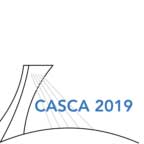
CASCA 2019
Jun 17 - 20, 2019 | Montréal, Québec

Radio/mm Astrophysical Frontiers in the Next Decade
Jun 25 - 27, 2019 | Charlottesville, VA

7th VLA Data Reduction Workshop
Oct 7 - 18, 2019 | Socorro, NM
2019 Jansky Fellowships Awarded
The National Radio Astronomy Observatory (NRAO) Jansky Fellowship program provides outstanding opportunities for research in astronomy. Jansky Fellows formulate and carry out investigations either independently or in collaboration with others within the wide framework of interests of the Observatory. The program is open each fall to candidates with interest in radio astronomy techniques, instrumentation, computation, and theory. Multi-wavelength projects leading to a synergy with NRAO instruments are encouraged. We are pleased to announce that three new Jansky Fellows will be joining NRAO in the fall of 2019.
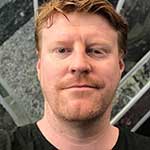 |
Craig Anderson is currently a Bolton Fellow at the Commonwealth Scientific and Industrial Research Organization (CSIRO) in Australia. Craig has extensive experience working as a member of the core commissioning team for the Australian Square Kilometre Array Pathfinder (ASKAP), with direct responsibility for ASKAP’s polarimetric capabilities. Craig will bring his background in radiometric polarimetry to the new science capabilities afforded by the VLA Sky Survey (VLASS) and the VLA. Craig will be hosted at NRAO Socorro. |
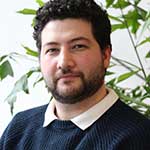 |
Luis Henry Quiroga-Nuñez is currently a Ph.D. candidate at Leiden Observatory and the Joint Institute for VLBI European Research Infrastructure Consortium (JIVE ERIC) working with Hub van Langevelde and Anthony Brown. Luis Henry has extensive experience on astrometric interferometric measurements using maser sources as tracers of the structure of our Galaxy. Luis Henry will bring his expertise in radiometric astrometry as a split Jansky Fellow at NRAO Socorro and the University of New Mexico working on the Bulge Asymmetries and Dynamical Evolution (BAaDE), Bar and Spiral Structure Legacy (BeSSeL), and Gaia projects. |
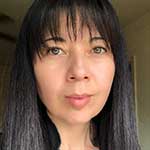 |
Dary Ruiz-Rodriguez is currently a postdoctoral and Gruber fellow at the Rochester Institute of Technology (RIT) working with Joel Kastner. Dary has broad expertise in the panchromatic study of young binary stars and the structure and evolution of circumstellar disks. Dary’s research utilizes the power of multispectral observations at infrared, millimeter, and x-ray wavelengths to characterize protoplanetary disks, providing the connections between planet formation and the ever-growing exoplanet population in our Galaxy. Dary expects to continue her study of the star and planet formation process using a variety of instruments, including ALMA and the VLA, as a Jansky Fellow at NRAO Charlottesville. |
2019 Jansky Lectureship – Call for Nominations
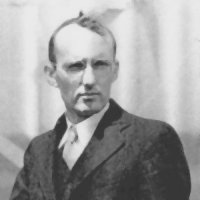
Karl Jansky
The Karl G. Jansky Lectureship is an honor established by the trustees of Associated Universities, Inc., to recognize outstanding contributions to the advancement of radio astronomy. First awarded in 1966, it is named in honor of the man who, in 1932, first detected radio waves from a cosmic source. Karl Jansky's discovery of radio waves from the central region of our Milky Way Galaxy started the science of radio astronomy.
The 2019 Jansky Lecturer will have made significant contributions related to radio astronomy, and will promote the appreciation of the science of radio astronomy through public lectures at the NRAO sites. A demonstrated ability to engage a wide audience will be a factor in determining the awardee. Visit the Jansky Lectureship website for a list of the previous recipients of this prestigious award.
Additional information, including the nomination and selection process, is available online.
Nominations for the 2019 award should be concise (~1 page) and address both the nominee’s contribution to the advancement of radio astronomy and their potential to increase public appreciation through the Jansky Lecture.
Nominations should be sent to jutley@nrao.edu by 5 April 2019.
NRAO scientific staff will be given an opportunity to vote on nominations received and the results will be included in the recommendation to the NRAO Director.
NRAO Postdoctoral Science Symposium
The 15th annual NRAO Postdoctoral Science Symposium will be held 11-12 April 2019 at the National Radio Astronomy Observatory in Charlottesville, Virginia. The annual symposium brings together the resident and non-resident Jansky Fellows and NRAO postdocs to highlight their current research, share ideas, and establish collaborations. Local NRAO scientific and engineering staff are also encouraged to attend.
We are pleased to have Dr. Adam Leroy, Associate Professor of Astronomy at Ohio State University, as our Keynote Speaker this year.
eXtra-Large Proposals
NRAO/LBO/GBO issued a call for submissions of Expressions of Interest (EoI) in eXtra-Large Proposals (X-Proposals) with a deadline of 31 August 2018. The Call is online.
A total of 27 EoIs were received, demonstrating a very high level of interest in the scientific potential of such large programs on all three instruments, and covering a wide range of astronomy.
Fourteen require only VLA time. Four require VLA time plus a much smaller amount of GBT time.
One requires substantial time on both the GBT and the VLA.
Two require only VLBA time. One requires VLBA time and a much smaller amount of VLA time.
Five require only GBT time.
The total observing time summed across all 27 EoIs is as follows:
- VLA 43,705 hours
- VLBA 8,728 hours
- GBT 17,537 hours
In comparison to semesters 18A-19A, the typical availability for Open Skies, PI science is:
- VLA 3,300 hours/semester
- VLBA 500 hours/semester
- GBT 2,600 hours/semester
As a result of the level of interest in observing programs of this scale, NRAO anticipates issuing a Call for Proposals for eXtra-Large projects using the VLA and the VLBA in the second half of 2019. The GBT may also participate in the call. The requirements for proposals and likely availability of time are currently under consideration, as is the mechanism for review of proposals and allocation of time. As stated in the call for EoIs:
- No time will be allocated on the basis of an EoI alone and there will be no requirement that an EoI was submitted prior to submission of a full proposal;
- X-Proposals will probably be assessed by a somewhat different process to that used for other VLA/VLBA/GBT proposals; and
- X-Proposal calls will probably be repeated on a longer timescale than the usual Semester cycle.
The specific EoIs received will not be considered further by the observatories.
A listing of the EoIs and PIs is available on-line.
ALMA Ambassadors Proposal Preparation Workshops
In advance of the ALMA Cycle 7 Call for Proposals deadline, the North American ALMA Science Center (NAASC), along with current ALMA Ambassadors, have organized a series of ALMA proposal preparation workshops at a number of North American institutions in March and April 2019. The goal of these events is to provide users with the knowledge they need to carry out cutting-edge scientific research using the ALMA facilities. We are particularly interested in reaching new users, so no experience with radio astronomy is required to participate!
These ALMA events are one-day workshops designed in cooperation with institutions across North America, and hosted by experienced local postdocs as part of the ALMA Ambassadors program. Registration is free. These events include science talks, an introduction to submillimeter interferometry, and hands-on tutorials designed to assist you in proposal preparation, and observation planning for ALMA Cycle 7. You will need to bring your laptop to participate in the hands-on sessions, and we will provide access to the free software that you can download.
If you are interested in attending an ALMA Proposal Preparation Workshop, the date, location, and ALMA Ambassador for each planned community day are listed below.
| Date | Location | Ambassador (Affiliation) |
|---|---|---|
| 20 March | Joint ALMA Observatory | David Rebolledo (JAO/NRAO) |
| 21 March | University of Maryland | Veronica Allen (NASA Goddard) & Kristina Nyland (NRL) |
| 22 March | Universidad de Concepción | David Rebolledo (JAO/NRAO) |
| 27 March | University of Florida | George Privon (UFL) |
| NASA JPL | Liton Majumdar (NASA JPL) | |
| 28 March | UC Berkeley | Megan Ansdell (UC Berkeley) |
| Northwestern University | Erin Cox (Northwestern) & Cassie Reuter (Illinois at Urbana-Champaign) | |
| Rochester Institute of Technology | Dary Ruiz-Rodriguez (RIT) | |
| 29 March | University of Toledo | Angus Mok (Toledo) & Dyas Utomo (OSU) |
| 1 April | CfA | Harvard & Smithsonian | María Jesus Jiménez-Donaire (CfA | Harvard & Smithsonian) |
| University of Toronto | Toby Brown (McMaster) | |
| 8 April | MIT | Allison Noble (MIT) |
| University of Texas at Austin | Justin Spilker (Texas) & Jorge Zavala (Texas) |
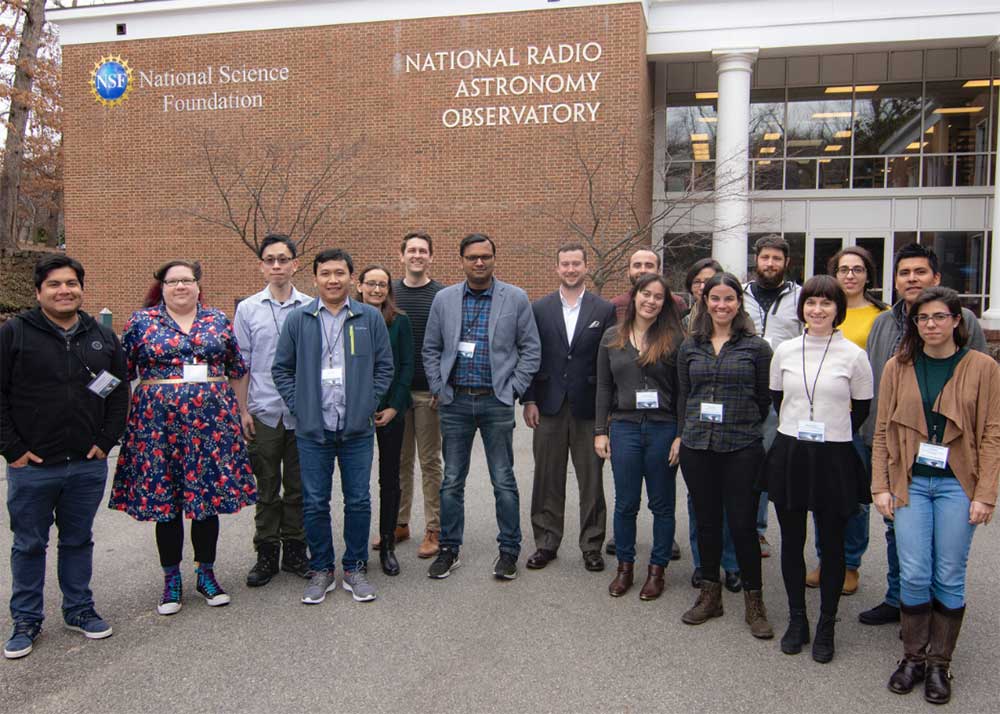
The 2019 ALMA Ambassadors [Left to Right]: David Rebolledo (JAO), Veronica Allen (NASA Goddard), Angus Mok (Toledo), Dyas Utomo (OSU), Kristina Nyland (NRL), Justin Spilker (UT-Austin), Liton Majumdar (NASA JPL), George Privon (UFL), Toby Brown (McMAster), Cassie Reuter (Illinois Urbana-Champaign), Megan Ansdell (UC-Berkeley), Erin Cox (Northwestern), Jon Ramsey (UVA guest), Allison Noble (MIT), Tannaz Farrahi (UVA guest), Jorge Zavala (UT-Austin), & Maria Jesus Jimenez Donaire (CfA).
[click to enlarge]
ALMA Program News
Cycle 6 Science Observing
Observations have resumed on ALMA, which is in its most compact configuration. Recent challenging weather and recovery from its effects was accomplished through extraordinary efforts of the staff, particularly the Antenna Team, but also involved power and road recovery. The array transforms to configuration C43-2 mid-Mar and to C43-3 in early Apr. Unfortunately, the Event Horizon Telescope run in Cycle 6 has been cancelled at team request due to technical difficulties at non-ALMA stations. Global 3mm VLBI Array (GMVA) observing including ALMA will continue as planned.
Cycle 7 Call for Proposals
A pre-announcement for the ALMA Cycle 7 Call for Proposals appeared at the ALMA Science Portal. The formal Call will be issued 19 Mar with proposals due 17 Apr 2019. The long term schedule has also been published. In Cycle 8, ALMA will not be moving out to the most extended baselines, C43-9 and C43-10. Proposals needing these baselines should be submitted for Cycle 7, or held for Cycle 9.
ALMA Science Sustainability
A Call for Proposals for ALMA Development Studies was released 3 Dec 2018. The deadline for proposals will be 1 May 2019 for funding during Fiscal Year 2020, depending on the federal budget process. The deadline for filing a Notice of Intent is 15 Mar 2019. We welcome any member from within the North America ALMA Operations Partnership to submit a proposal to investigate a potential ALMA upgrade (hardware, software, or advanced techniques). Particular attention should be given to ideas which may address the goals elucidated in The ALMA Development Roadmap, ALMA Memo 612.
ALMA2019: Science Results and Cross-Facility Synergies
The next ALMA-wide science conference will be held 14-18 Oct 2019 in Cagliari, Sardinia, Italy. The first general ALMA science conference took place at the Carnegie Institute in Washington, D.C. in Oct 1999; the second in Madrid, Spain in Nov 2006; the third (with ALMA operating) in Puerto Varas, Chile in Dec 2012; the fourth in Tokyo, Japan in Dec 2014; and the fifth was in Indian Wells, California, in Jun 2016. We hope that you will present your transformational ALMA science at the 2019 conference! As in previous editions of the conference series, we expect to also discuss the scientific priorities for the implementation of the ALMA Development Roadmap.
| Abstract submission deadline | 15 May 2019 |
| Notification of talk selection | 1 July 2019 |
| Regular registration deadline | 31 July 2019 |
| Late registration deadline | 13 September 2019 |
| Registration will open | Second week of March 2019 |
New Horizons in Planetary Systems
This science conference jointly organized by National Research Council – Herzberg and the NRAO North American ALMA Science Center will take place 13-17 May 2019. This conference will have a broad scope, including planetary systems in formation within protoplanetary disks, minor objects in the solar system, debris disks and exoplanets, with a focus on ALMA observations and/or talks related to areas of ALMA observations. As the name suggests, we plan to highlight results from the New Horizons spacecraft. See the full program at the conference website.
Early Bird Registration ends Friday, 15 March 2019!
The meeting will be held at the Victoria Conference Center in the heart of picturesque Victoria, British Columbia, on Canada's Pacific coast. Registration and late abstract submission remain open through 12 Apr 2019. There is a hard cap on meeting attendance of 250 participants so register today.
ngVLA Project News

Oral Abstracts Submission Deadline *next week* 18 March 2019 for Radio/mm Astrophysical Frontiers in the Next Decade.
With the Astro2020 science white paper deadline behind us, and ~600 white papers submitted, there will be a broad range of exciting science to discuss during this workshop. Please submit an abstract that highlights the science included in your white papers.
Abstract and Requests for Travel Grants are due next Monday, 18 March 2019.
The discounted registration deadline is 6 May 2019. Space is limited, so register today!
Participation from early career astronomers is strongly encouraged. All students presenting either an oral talk (if selected) or a poster, will be offered hotel rooms free of cost for up to four nights in addition to discounted registration fees.
Registration | Abstract submission
This workshop will review the astrophysical frontiers identified in the Science White Papers submitted to the Astro2020 Decadal Survey. A particular focus will be on those science frontiers that demand observations at centimeter and/or millimeter wavelengths across all Astro2020 thematic areas. A broad range of innovative ideas and approaches will be described, and this workshop will allow those ideas to be explored in view of the current and forthcoming facilities, including the next generation Very Large Array (ngVLA). The program will be designed primarily around contributed presentations highlighting science frontiers and potential observations with the ngVLA. Such observations will additionally be discussed in the broader context of multi-wavelength and multi-messenger astronomy. Contributions from early career researchers will be especially welcomed.
The ngVLA will proceed into a detailed design and development phase in 2020. The ngVLA Science Advisory Council and the NRAO aim to ensure that the ngVLA will be capable of making the measurements required to fulfill the community’s vision for radio wavelength astronomy over the next decade and beyond.
For this workshop, we anticipate there being a modest amount of travel support for students and those in need, upon request. Please visit the conference website for additional information.
VLA Sky Survey Epoch 1 Observing Resumes
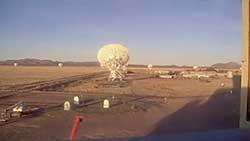
[click image to view video on Twitter]
The sun sets on the first day of VLASS1.2 observations. This time-lapse is composed of three hours of VLA webcam images compressed into 19 seconds and can be viewed on the NRAO Twitter account, thanks to G. Moellenbrock.

[click image to view video on Twitter]
The sun sets on the first day of VLASS1.2 observations. This time-lapse is composed of three hours of VLA webcam images compressed into 19 seconds and can be viewed on the NRAO Twitter account, thanks to G. Moellenbrock.
The VLA Sky Survey is a new 2-4GHz, multi-epoch, all-sky radio survey. It is the highest resolution all-sky radio survey ever undertaken, and is being observed in the VLA's B and BnA configurations. The first half of the first epoch (VLASS1.1) was observed between September 2017 and February 2018, after which the VLA continued through the regular A, D, and C configuration cycle. Observing for the second half of the sky (VLASS1.2) began on March 5 after moving back to the B configuration and will continue through July, to complete the almost 34,000 square degrees of sky accessible to the VLA. Initial "Quick Look" images for VLASS1.2 will start to be delivered this week, and may be found at the VLASS website.
Erin Cox Receives Bob Brown Dissertation Award
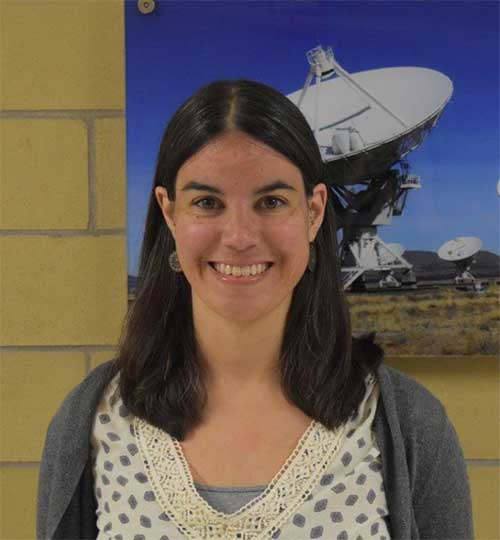
Erin Cox
[click to enlarge]
The 2018 Robert L. Brown Outstanding Doctoral Dissertation Award has been awarded to Erin Cox for her dissertation entitled Probing Planetary Disks: from Birth to Protoplanets. Her thesis was selected for its clear objectives and thoughtful observational approach. Her insights and conclusions make original and significant contributions to our understanding of the early protostellar-cloud collapse process from which the planets are forming. The extensive set of new observations and her interpretation provide realistic glimpses into the density and magnetic structures, kinematics, and available energy budgets on resolution scales of a few tens of AU that will guide future magnetohydrodynamic simulations of the conditions under which planets of various masses and orbital radii are likely to form in nascent protostellar cloud complexes. The award will be presented during a ceremony to be held at NRAO on 21 March 2019.
Erin received her Ph.D. in 2018 in Astronomy from the University of Illinois and her B.S. in Astronomy and Physics from the University of Arizona in 2012. She is currently a Postdoctoral Associate at the Northwestern University Center for Interdisciplinary Exploration and Research in Astrophysics where she is continuing her studies on star and planet formation focusing on how magnetic fields influence the earliest stages of protostellar collapse and how this affects disk formation.
The Robert L. Brown Outstanding Doctoral Dissertation Award is administered by AUI and the NRAO on behalf of Bob Brown’s friends and family to honor Bob’s life and career. The Award is given each year to a recent recipient of a doctoral degree from any recognized degree granting institution in the United States, that is substantially based on new observational data obtained at any AUI facility and is considered to be of an exceptionally high scientific standard. Applications for the 2019 Award should be sent to rlbaward@nrao.edu no later than 31 December 2019.
Radio Astronomy Workshops at the University of the West Indies

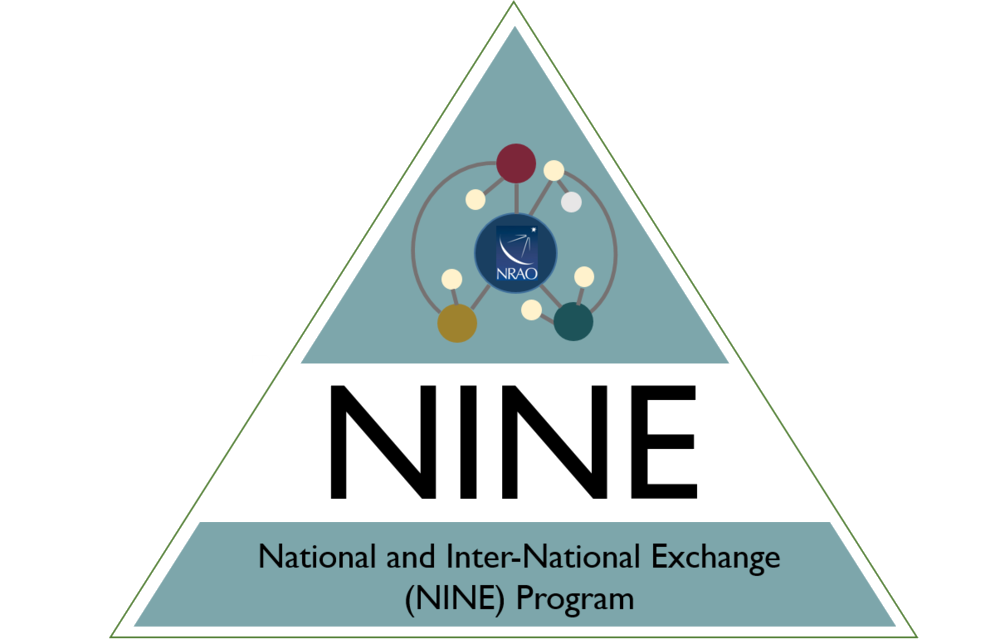
In January 2019, the University of the West Indies at St. Augustine in Trinidad (UWI) hosted two student workshops. The UWI hub, headed by Dr. Shirin Haque, is part of the National and International Non-Traditional Exchange (NINE) program and, in collaboration with NRAO’s Office of Diversity and Inclusion, aims to train students and broaden participation via short courses on radio astronomy, data mining, and computing.
Students had the opportunity to learn all about the NRAO and its history in radio astronomy, an introduction to Python programming, and mining sources of astronomical data from NRAO telescope facilities and projects, including the new VLA Sky Survey (VLASS). Students worked on exercises and examples by utilizing Raspberry Pis – inexpensive single board computers suitable for data and image manipulation. As a result of its participation, UWI has formed a group called the Trinidad Radio Astronomy Community (TRAC) aimed at further engaging students and faculty in the pedagogy presented in the workshop.
NRAO will continue its NINE program in summer 2019. More information about opportunities with NINE can be found online.
NAC Alumni Win Chambliss Awards
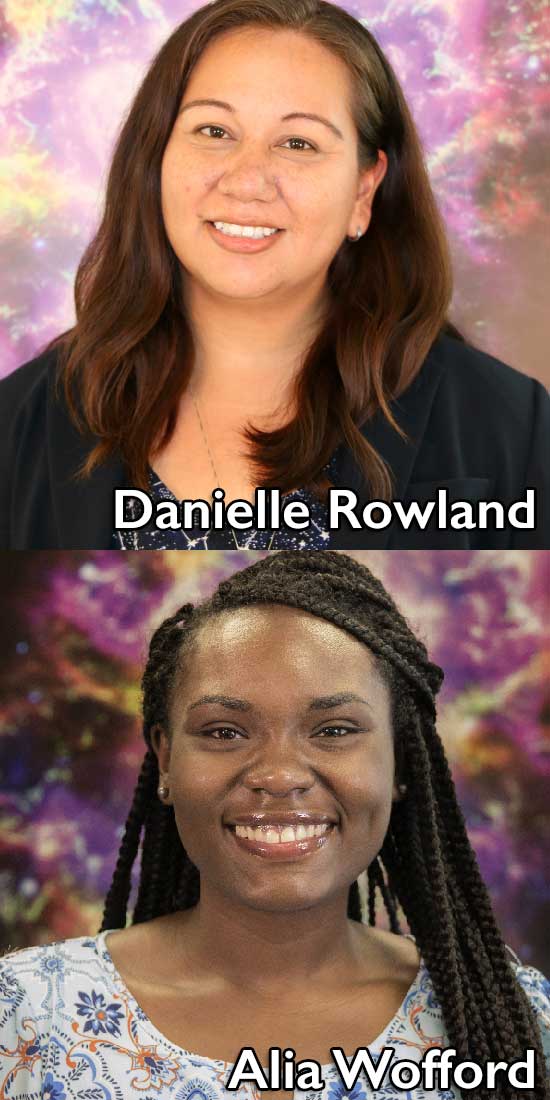
The NRAO is pleased to note that two National Astronomy Consortium (NAC) alumni received Chambliss Awards for their poster presentations at the at the 233rd American Astronomical Society Meeting in Seattle, Washington in January 2019.
Danielle Rowling, a senior Columbia University, received an Undergraduate Chambliss Award for her poster presentation titled Satellite Galaxy Characteristics in the SAGA Survey.
Alia Wofford, Research Scientist and NASA Goddard Post-Baccalaureate Scholar, received a Chambliss Graduate Honorable Mention for her poster presentation, Revisiting the Early Earth's Methanogen Biosphere.
Congratulations to Danielle and Alia!
Astronomy in Chile Educator Ambassadors Program
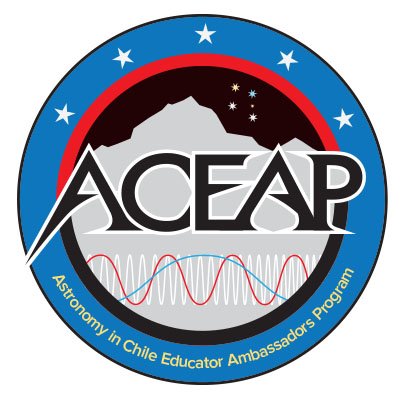
Are you interested in visiting some of the largest and most sophisticated observatories and telescopes in the world? Do you like sharing your knowledge and astronomical experiences with others? Then check out the Astronomy in Chile Educator Ambassadors Program (ACEAP) and APPLY TODAY! The application deadline has been extended to 24 Mar 2019 at 11:59 p.m. EDT.
The 2019 ACEAP Expedition to Chile will take place 27 July – 5 August, and is open to U.S. and international participants. Here are the basics:
- The 2019 ACEAP Team will include a team of 10 individuals.
- It is intended that five slots will be supported by National Science Foundation (NSF) funding (excluding air travel in Chile, and roundtrip air to Santiago) through the normal ACEAP application and review process. No additional fees will be charged. These five slots are open to those in the U.S. or U.S. Territory. Please note that while we anticipate NSF support for the 2019 Expedition, this has not yet been secured. We anticipate confirmation in the near future.
- Four slots will be made available to anyone in the U.S. or abroad who has interest/experience in astronomy education/outreach. Their experience will have to be fully paid for by their institution or self-funded. Cost = $4200 USD excluding roundtrip airfare to Santiago. These will be filled on a first come first serve basis once initial qualifications have been met.
- One slot will be awarded to a Chilean educator who is embedded on the Team.
- All 10 Ambassadors will be required to participate in pre-travel sessions and complete the outreach activities when they come home. In return, each receives a $500 stipend.
From the Archives
Ellen Bouton

[click to enlarge]
About this month's photo: Before any Very Large Array construction began, there was extensive soil testing at the site in the center and along all the proposed arms. Environmental engineering firms, geologists from New Mexico Tech, several local drilling companies, and local excavators were all involved in the multi-month process, and many core samples were extracted for analysis. In this 31 August 1973 photo, the rig from Albuquerque Testing is drilling a test hole on the southwest arm to extract core samples. The Lorenzo well is in the background.
From the Archives is an ongoing series illustrating NRAO and U.S. radio astronomy history via images selected from our collections of individuals' and institutional papers. If readers have images they believe would be of interest to the Archives, please contact Ellen Bouton.


